Legend
A legend is a genre of folklore that consists of a narrative featuring human actions perceived or believed both by teller and listeners to have taken place within human history. Narratives in this genre may demonstrate human values, and possess certain qualities that give the tale verisimilitude. Legend, for its active and passive participants, includes no happenings that are outside the realm of "possibility," but may include miracles. Legends may be transformed over time, in order to keep them fresh, vital, and realistic. Many legends operate within the realm of uncertainty, never being entirely believed by the participants, but also never being resolutely doubted.[1]
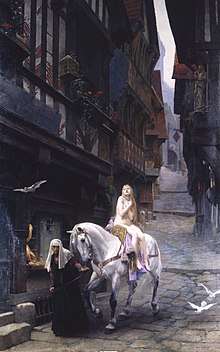
The Brothers Grimm defined legend as "folktale historically grounded".[2] A modern folklorist's professional definition of legend was proposed by Timothy R. Tangherlini in 1990:[3]
Legend, typically, is a short (mono-) episodic, traditional, highly ecotypified[4] historicized narrative performed in a conversational mode, reflecting on a psychological level a symbolic representation of folk belief and collective experiences and serving as a reaffirmation of commonly held values of the group to whose tradition it belongs.
Etymology and origin
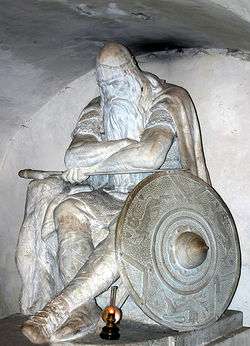
Legend is a loanword from Old French that entered English usage circa 1340. The Old French noun legende derives from the Medieval Latin legenda.[5] In its early English-language usage, the word indicated a narrative of an event. The word legendary was originally a noun (introduced in the 1510s) meaning a collection or corpus of legends.[6][7] This word changed to legendry, and legendary became the adjectival form.[6]
By 1613, English-speaking Protestants began to use the word when they wished to imply that an event (especially the story of any saint not acknowledged in John Foxe's Actes and Monuments) was fictitious. Thus, legend gained its modern connotations of "undocumented" and "spurious", which distinguish it from the meaning of chronicle.[8]
In 1866, Jacob Grimm described the fairy tale as "poetic, legend historic."[9] Early scholars such as Karl Wehrhan[10] Friedrich Ranke[11] and Will Erich Peuckert[12] followed Grimm's example in focussing solely on the literary narrative, an approach that was enriched particularly after the 1960s,[13] by addressing questions of performance and the anthropological and psychological insights provided in considering legends' social context. Questions of categorising legends, in hopes of compiling a content-based series of categories on the line of the Aarne–Thompson folktale index, provoked a search for a broader new synthesis.
.jpg)
In an early attempt at defining some basic questions operative in examining folk tales, Friedrich Ranke in 1925[15] characterised the folk legend as "a popular narrative with an objectively untrue imaginary content" a dismissive position that was subsequently largely abandoned.[16]
Compared to the highly structured folktale, legend is comparatively amorphous, Helmut de Boor noted in 1928.[17] The narrative content of legend is in realistic mode, rather than the wry irony of folktale;[18] Wilhelm Heiske[19] remarked on the similarity of motifs in legend and folktale and concluded that, in spite of its realistic mode, legend is not more historical than folktale.
In Einleitung in der Geschichtswissenschaft (1928), Ernst Bernheim asserted that a legend is simply a longstanding rumour.[20] Gordon Allport credited the staying-power of some rumours to the persistent cultural state-of-mind that they embody and capsulise;[21] thus "Urban legends" are a feature of rumour.[22] When Willian Jansen suggested that legends that disappear quickly were "short-term legends" and the persistent ones be termed "long-term legends", the distinction between legend and rumour was effectively obliterated, Tangherlini concluded.[23]
Christian legenda
In the narrow Christian sense, legenda ("things to be read [on a certain day, in church]") were hagiographical accounts, often collected in a legendary. Because saints' lives are often included in many miracle stories, legend, in a wider sense, came to refer to any story that is set in a historical context but that contains supernatural, divine or fantastic elements.[24]
Related concepts
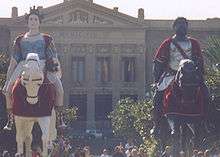
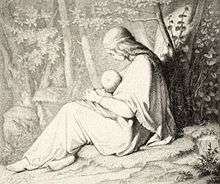
Hippolyte Delehaye distinguished legend from myth: "The legend, on the other hand, has, of necessity, some historical or topographical connection. It refers imaginary events to some real personage, or it localizes romantic stories in some definite spot."[25]
From the moment a legend is retold as fiction, its authentic legendary qualities begin to fade and recede: in The Legend of Sleepy Hollow, Washington Irving transformed a local Hudson River Valley legend into a literary anecdote with "Gothic" overtones, which actually tended to diminish its character as genuine legend.[26]
Stories that exceed the boundaries of "realism" are called "fables". For example, the talking animal formula of Aesop identifies his brief stories as fables, not legends. The parable of the Prodigal Son would be a legend if it were told as having actually happened to a specific son of a historical father. If it included a donkey that gave sage advice to the Prodigal Son it would be a fable.
Legend may be transmitted orally, passed on person-to-person, or, in the original sense, through written text. Jacob de Voragine's Legenda Aurea or "The Golden Legend" comprises a series of vitae or instructive biographical narratives, tied to the liturgical calendar of the Roman Catholic Church. They are presented as lives of the saints, but the profusion of miraculous happenings and above all their uncritical context are characteristics of hagiography. The Legenda was intended to inspire extemporized homilies and sermons appropriate to the saint of the day.[27]
Urban legend
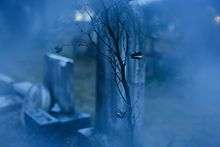
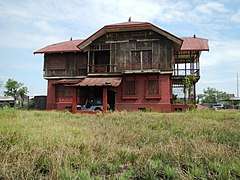
Urban legends are a modern genre of folklore that is rooted in local popular culture, usually comprising fictional stories that are often presented as true, with macabre or humorous elements. These legends can be used for entertainment purposes, as well as semi-serious explanations for seemingly-mysterious events, such as disappearances and strange objects.
The term "urban legend," as used by folklorists, has appeared in print since at least 1968.[28] Jan Harold Brunvand, professor of English at the University of Utah, introduced the term to the general public in a series of popular books published beginning in 1981. Brunvand used his collection of legends, The Vanishing Hitchhiker: American Urban Legends & Their Meanings (1981) to make two points: first, that legends and folklore do not occur exclusively in so-called primitive or traditional societies, and second, that one could learn much about urban and modern culture by studying such tales.
See also
- The Matter of Britain, Arthurian legend
- Legendary saga
- Lists of legendary creatures
References
- Georges, Robert; Owens, Michael (1995). Folkloristics. United States of America: Indiana University Press. p. 7. ISBN 0-253-32934-5.
- Norbert Krapf, Beneath the Cherry Sapling: Legends from Franconia (New York: Fordham University Press) 1988, devotes his opening section to distinguishing the genre of legend from other narrative forms, such as fairy tale; he "reiterates the Grimms' definition of legend as a folktale historically grounded", according to Hans Sebald's review in German Studies Review 13.2 (May 1990), p 312.
- Tangherlini, "'It Happened Not Too Far from Here...': A Survey of Legend Theory and Characterization" Western Folklore 49.4 (October 1990:371–390) p. 385.
- That is to say, specifically located in place and time.
- Oxford English Dictionary, s.v. "legend"
- Harper, Douglas. "legendary". Online Etymology Dictionary. Retrieved 10 June 2013.
- "legendry". Merriam-Webster Dictionary.
- Patrick Collinson. Elizabethans, "Truth and Legend: The Veracity of John Foxe's Book of Martyrs" 2003:151–77, balances the authentic records and rhetorical presentation of Foxe's Acts and Monuments, itself a mighty force of Protestant legend-making. Sherry L. Reames, The Legenda Aurea: a reexamination of its paradoxical history, 1985, examines the "Renaissance verdict" on the Legenda, and its wider influence in skeptical approaches to Catholic hagiography in general.
- Das Märchen ist poetischer, die Sage, historischer, quoted at the commencement of Tangherlini's survey of legend scholarship (Tangherlini 1990:371)
- Wehrhan Die Sage (Leipzig) 1908.
- Ranke, "Grundfragen der Volkssagen Forshung", in Leander Petzoldt (ed.), Vergleichende Sagenforschung 1971:1–20, noted by Tangherlini 1990.
- Peuckert , Sagen (Munich: E Schmidt) 1965.
- This was stimulated in part, Tangherlini suggests, by the 1962 congress of the International Society for Folk Narrative Research.
- "Lapu-Lapu in Folk Tradition" by Resil B. Mojares, University of San Carlos
- Ranke, "Grundfragen der Volkssagenforschung", Niederdeutsche Zeitschrift für Volkskunde 3 (1925, reprinted 1969)
- Charles L. Perdue Jt., reviewing Linda Dégh and Andrew Vászony's essay "The crack on the red goblet or truth and the modern legend" in Richard M. Dorson, ed. Folklore in the Modern World, (The Hague: Mouton)1978, in The Journal of American Folklore 93 No. 369 (July–September 1980:367), remarked on Ranke's definition, criticised in the essay, as a "dead issue". A more recent examination of the balance between oral performance and literal truth at work in legends forms Gillian Bennett's chapter "Legend: Performance and Truth" in Gillian Bennett and Paul Smith, eds. Contemporary Legend (Garland) 1996:17–40.
- de Boor, "Märchenforschung", Zeitschrift für Deutschkunde 42 1928:563–81.
- Lutz Röhrich, Märchen und Wirklichkeit: Eine volkskundliche Untersuchung (Wiesbaden: Steiner Verlag) 1956:9–26.
- Heiske, "Das Märchen ist poetischer, die Sage, historischer: Versuch einer Kritik", Deutschunterricht14 1962:69–75..
- Bernheim, Einleitung in der Geschichtswissenschaft(Berlin: de Gruyter) 1928.
- Allport, The Psychology of Rumor (New York: Holt, Rinehart) 1947:164.
- Bengt af Klintberg, "Folksägner i dag" Fataburen 1976:269–96.
- Jansen, "Legend: oral tradition in the modern experience", Folklore Today, A Festschrift for William Dorson (Bloomington: Indiana University Press) 1972:265–72, noted in Tangherlini 1990:375.
- Literary or Profane Legends. Catholic Encyclopedia
- Hippolyte Delehaye, The Legends of the Saints: An Introduction to Hagiography (1907), Chapter I: Preliminary Definitions
- Encyclopaedia Britannica (2006). "Fable". Britannica Concise Encyclopedia. Chicago, Illinois: Encyclopedia Britannica. p. 652. ISBN 9781593392932.
- Timothy R. Tangherlini, "'It Happened Not Too Far from Here...': A Survey of Legend Theory and Characterization" Western Folklore 49.4 (October 1990:371–390). A condensed survey with extensive bibliography.
- Oxford English Dictionary, 2d ed. 1989, entry for "urban legend," citing R. M. Dorson in T. P. Coffin, Our Living Traditions, xiv. 166 (1968). See also William B. Edgerton, The Ghost in Search of Help for a Dying Man, Journal of the Folklore Institute, Vol. 5, No. 1. pp. 31, 38, 41 (1968).